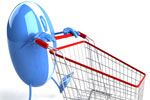Monday 20 February, 2012
If your goal is for people to buy from your website, your
website needs to "sell" your products or services well. To do this,
instead of starting from your home page - and then trying to lead the
site visitor on a path to each product or service - start from the end
and work backwards. Pick any product (or service), and follow this
four-step process to craft a path through your website that will turn
visitors into buyers.
 What do you want them to do?
What do you want them to do?
Assuming the person is ready to take action, what action do you want them to take? Or, to put it another way: What is the last thing you want them to do before they leave your website?
Maybe you want them to actually buy with a credit card, or book a date on a calendar, or register for an event, or pick up the phone and call you, or ... It's up to you, and it will vary for each product or service. But be very clear about this in your mind.
Make sure expectations are reasonable and realistic. For example, if I'm selling a $35 book, it's reasonable to ask them to whip out their credit card. But if I'm selling a $6,000 mentoring program, it's not.
Another example: Depending on your market, some conference organisers and bureaus will be happy to send you an e-mail to check your availability for an event; others will want to pick up the phone and check; and others will want to place a "hold" immediately on your on-line calendar. Be sure you know which option to offer!
- Why will they buy?
Before they take the action, you need to convince them it's worth doing. That's where your sales letter comes in. The key point when writing good sales letters is that you should write some form of sales letter for each product and service you offer.
If you don't like the term "sales letter", think of it as a brochure or flyer.
- What can you give?
Before you start selling to them, what free, high-quality content can you offer that's related to their problem or goal? This could be an article, a survey, a video, an audio clip, or a slide presentation. At the end of that content piece, you link to the sales letter.
You don't need to do this if you know your website visitors are coming to the site ready to buy. For example, people go to Amazon.com because they want to buy books, not to find free information to help solve a problem. So Amazon.com can get away with only providing sales letters. You probably can't.
- How will they see it?
So far, you've got some high-quality content, which leads to a sales letter, which then invites the site visitor to take action. But how will they find this sequence on your website?
This is where you have to decide how important this product or service is to your business. If it's very important, you will feature it on the home page (with a link to the content piece). If it's less important, it might only be accessible through your menus.
You've now crafted a clear path for your site visitors
If we take these steps in reverse, you'll see a clear path that promotes that product or service:- They see something interesting on your home page or menu, and they click it
- They read, listen or watch some high-quality content that helps them with their problem, and it links to something else
- They click that and read the sales letter, which invites them to take some action
- They take the action you want them to take!
Source:ceoonline.com

No comments:
Post a Comment